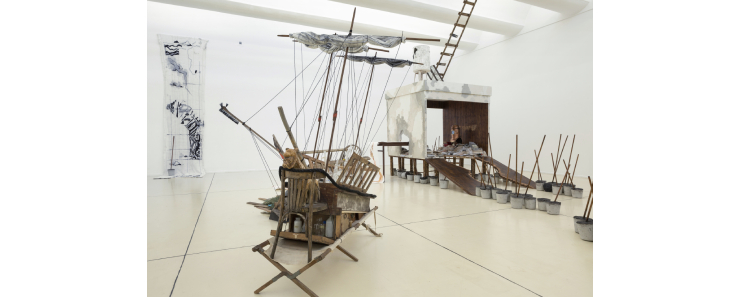
The solo exhibition of the multidisciplinary artist Nivi Alroy begins a moment after that extinction. It consists of several site-specific installations that depict seductive and frightening visions of a future world re-emerging in the wake of global ecological destruction. Alroy’s work is based on actual scientific research in the fields of biology, oceanography, and ecology (which she became deeply acquainted with during an art residency program at the Hebrew University of Jerusalem), coupled with experiences and memories of her family. Although Alroy relies on real-world materials, she transforms them to create a fictional and poetic work in which scientific facts and predictions serve only as a starting point. The destruction of life on earth will occur, according to scientific predictions, as a result of ongoing and complex processes: atmospheric warming; flooding of the land by the seas and oceans due to melting glaciers; damage to natural resources and their aggressive exploitation; and irrevocable disruption of the ecological balance that has nourished and preserved a host of processes and organisms on earth for thousands of years – including ourselves, the human race. By mapping the past (that is, our present), Alroy’s sculptural installations portray the world after the calamity as an evolutionary hybrid made up of the remains of a destroyed civilization.
At the western entrance to the large space is a raft-shaped structure, a hybrid of artificial and organic forms: debris from the seafloor, parts of furniture, and a cluster of plastic residues. All of these have joined together into a freakish ecosystem, which is unlikely to manage to deliver its inhabitants to safety. At the center of the space is a wooden home that has been flooded. Surrounding it are innumerable buckets of concrete, that have seemingly proliferated, unchecked, of their own accord. On the roof of the wooden structure rises a high ladder that leads to nowhere, and stops at the ceiling of the hall, as a potential, but hopeless, escape route.
Visitors to the exhibition are invited to cross the building through a depressed route that traverses the building. This is a range of peaks whose shape resembles the Mariana Trench – a chain of underwater precipices that surround the deepest known depression on the Earth’s surface. A long map hangs from the drawing table of the researcher Marie Tharp, and a submarine is reminiscent of the famous Alvin submarine, which has set out since the early 1960s to collect data and findings at the bottom of the Atlantic Ocean. At the end of the hall hangs another long map pertaining to Tharp’s research – including the movement of the tectonic plates due to the expansion of the ocean floor, and a zebra formation that describes the pattern of switching of the Earth’s magnetic poles.
The exhibition space will serve as an arena for performances, meetings, and collaborations with artists and researchers from the fields of dance, music and science. The upper gallery presents an audiovisual project that accompanies this exhibition, The Mariana Trench – Flooding, a radio play and screening, the product of Alroy’s collaboration with the artist and author Moran Shoub.
The exhibition is generously supported by Outset Contemporary Art Fund; Israel Lottery Council for Culture and the Arts; Friends of the Museum, Yael and Zohar Gilon; and B.I.T Real Estate Enterprise & Development Ltd.
NIVI ALROY AND MORAN SHOUB: MARIANA TRENCH – FLOODING
This audiovisual project is an extension and expansion of Nivi Alroy’s exhibition The Mariana Trench in the Large Gallery, which presents a future vision of our world in the aftermath of the “Sixth Extinction.” The radio play, a joint work by Alroy and Moran Shoub, recreates the atmosphere and soundtrack of radio plays and other broadcasts from the 1950s. Both the exhibition and the play blur the boundaries between personal and global, between a flooded apartment and environmental and ecological phenomena, and between the biographical and the imagined.
The play depicts the American researcher and cartographer Marie Tharp, who mapped the bottom of the Atlantic Ocean in the 1950s and 1960s. Despite the difficulties she encountered as a woman prevented from embarking on ocean missions with fellow male divers, Tharp’s research work proved the theory of continental drift. In the radio play, which blends together fact and fiction, Tharp corresponds with Bruce Heezen – a geologist who went down in the submarine to the seafloor and relayed seismic information on which she based her work. A narrator joins their conversation, and the play also incorporates quotations from Hebrew poetry: “What Do You Call” by Avot Yeshurun, and “Closer to Magic, Better That We Should Know” by Yair Hurwitz.
Less Reading...


